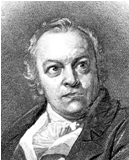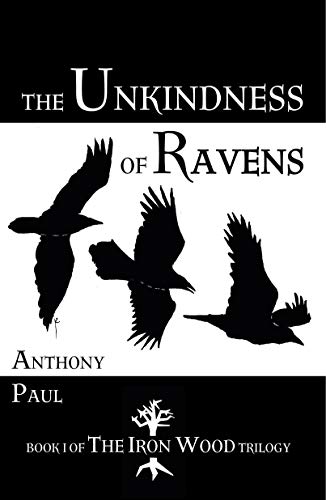Songs of Innocence and Experience by William Blake
Page 8 of 18 - 1 2 3 4 5 6 7 8 9 10 11 12 13 14 15 16 17 18 Purchase full notes for £5.95 (aprox $9.28)
The stark opposites of black and white are also important in the poem. In this copy, Blake (who hand-coloured all his prints) has made the little black boy white (indicating his spiritual whiteness), and only his hair remains dark. In other copies his is coloured black as in the first illustration. In the second, Christ is seen as the Good Shepherd with his crook. His sheep are golden (which is the colour of the sky in the first illustration); while the sky over Christ is light blue, and blue and gold are frequently used as heavenly colours in the Songs of Innocence .
The first stanza explores some typical Blakean contraries: ‘black/white’, ‘angel/devil’. Blake’s dialectic of contraries is that both are equally valid, though in reality one is often suppressed or devalued by the other, so blacks are often suppressed by whites; angels are seen as good and devils as evil . His poem is an obvious attempt to redress the balance between ‘black’ and ‘white.’ The first stanza, for example, sounds like a challenge to racist attitudes of the time, with ‘I am black’ repeated twice, the second time in an alliterative phrase, ‘But I am black as if bereav’d of light.’ To be ‘black’ and ‘bereav’d of light’ implies the world of experience, but, in fact, the little black boy’s young life is not deprived, but an archetypal ‘innocent’ upbringing. It is at one with nature and the mother-figure (‘My mother taught me underneath a tree’), while the symbols of the mother pointing to the ‘east’ and of the ‘rising sun’ (depicted in the first illustration) both suggests the resurrection of Jesus. The black boy is also pointing upwards, towards the heavens, in the picture.
The boy’s mother teaches an archetypal innocent view of God, for the first time in Songs of Innocence . God is seen as dispensing love ‘on good and bad at once’ as the gospel puts it, loving ‘flowers and trees and beasts and men’ through the warmth of the sun. The human vocation is then seen as reflexive. We are loved, but we must learn to bear that love (both in the sense of accepting it ourselves, and then in bearing it to others). The child’s black skin, therefore, is an indication of how much of God’s love he is able to bear , and this paradoxically makes him ‘whiter’ in the spiritual sense than ‘little English boy’ (note Blake’s parody of pidgin English). As a bearer of love, the little black boy still loves the English boy who, it may be presumed, despises him; but in heaven, the black boy’s love shields the white boy until he can ‘lean in joy upon our father’s knee.’
This poem is the first to use the word ‘cloud’ in its special Blakean sense. A cloud hides something in Blake – here the true spiritual reality of something. A cloud also can disappear quickly, and a key teaching of this poet is that if only we could see clearly, the ‘clouds’ (here black skin or white skin) that distort our vision would disappear instantly.
[...]
The first stanza explores some typical Blakean contraries: ‘black/white’, ‘angel/devil’. Blake’s dialectic of contraries is that both are equally valid, though in reality one is often suppressed or devalued by the other, so blacks are often suppressed by whites; angels are seen as good and devils as evil . His poem is an obvious attempt to redress the balance between ‘black’ and ‘white.’ The first stanza, for example, sounds like a challenge to racist attitudes of the time, with ‘I am black’ repeated twice, the second time in an alliterative phrase, ‘But I am black as if bereav’d of light.’ To be ‘black’ and ‘bereav’d of light’ implies the world of experience, but, in fact, the little black boy’s young life is not deprived, but an archetypal ‘innocent’ upbringing. It is at one with nature and the mother-figure (‘My mother taught me underneath a tree’), while the symbols of the mother pointing to the ‘east’ and of the ‘rising sun’ (depicted in the first illustration) both suggests the resurrection of Jesus. The black boy is also pointing upwards, towards the heavens, in the picture.
The boy’s mother teaches an archetypal innocent view of God, for the first time in Songs of Innocence . God is seen as dispensing love ‘on good and bad at once’ as the gospel puts it, loving ‘flowers and trees and beasts and men’ through the warmth of the sun. The human vocation is then seen as reflexive. We are loved, but we must learn to bear that love (both in the sense of accepting it ourselves, and then in bearing it to others). The child’s black skin, therefore, is an indication of how much of God’s love he is able to bear , and this paradoxically makes him ‘whiter’ in the spiritual sense than ‘little English boy’ (note Blake’s parody of pidgin English). As a bearer of love, the little black boy still loves the English boy who, it may be presumed, despises him; but in heaven, the black boy’s love shields the white boy until he can ‘lean in joy upon our father’s knee.’
This poem is the first to use the word ‘cloud’ in its special Blakean sense. A cloud hides something in Blake – here the true spiritual reality of something. A cloud also can disappear quickly, and a key teaching of this poet is that if only we could see clearly, the ‘clouds’ (here black skin or white skin) that distort our vision would disappear instantly.
[...]

